How to Make Open Education for Older Adults More Attractive: Inspirations from
the Open University of Japan
Wang Zhuguo1 Xu Jinpei2
Abstract: China has entered a period of population ageing, and various types of universities and educational institutions for older adults are constantly emerging. Under the influence of government planning and based on considerations for their own future development, open universities and radio and TV universities have all started open universities for older adults. What purpose do open universities for older adults serve, and how do they operate? In order to demonstrate their differences from ordinary universities or educational institutions, this paper will focus on the hard work of building an education system for older adults that has been done in the field of degree continuing education. The Open University of Japan (OUJ) has a great deal of experience in serving continuing education for older adults, which is worth learning from.
Key Words: Open university for older adults; Ageing; Learning diversity; Learning adaptability; Learning convenience; Degree education; Non-degree training; Operation strategy; Inspirations
In recent years, open and distance education for older adults has drawn more attention from all walks of life. Similarly, open universities for older adults have sprung up across China. According to incomplete statistics, to date, open universities for older adults or colleges for older citizens have been established in 26 open universities or radio and TV universities (RTVUs) across China (Ministry of Education, 2019). Most are able to offer education and teaching by relying on open universities or RTVUs. Their main goal is to provide older with distance non-degree education, but there are also a few open universities for older adults that can provide older adults with degree continuing education. Open universities for older adults have made great efforts to create websites, integrate resources, and develop projects, and have made good progress. However, there is still a great gap between their achievements and the policy-based requirements of the Party and the state, as well as the learning needs of many older adults.
I. The opportunities for and challenges facing open universities for older adults
It is clear that now is the right time for the development of open universities for older adults. On the one hand, the government is paying more attention to education for older adults. On the other hand, older adults have a clear need for education, of which there is insufficient supply. All this has created unprecedented opportunities for the development of open universities for older adults.
The communique of the fourth plenary session of the 19th Central Committee of the Communist Party of China explicitly noted the need to “build an education system that serves lifelong learning for all.” The Opinions on Promoting the Development of Old-Age Services (State Council, 2019) underlined the need to vigorously develop education for older adults. The development of community education for older adults prioritises the establishment of a three-level “county (city, district), township (neighbourhood), village (neighbourhood committee)” operation network. A national public service platform for education for older adults should be established, and a range of educational institutions should be encouraged to give or participate in education for older adults. The sharing of resources, courses, and teachers for education for older adults will be promoted in order to explore a new model integrating geriatric care and education and giving support to communities, education institutions for older adults, and elderly care service institutions. Methods and approaches for universities for older adults run by departments, industrial enterprises and institutions of higher education should be explored. This has charted the way for the development of open universities for older adults.
China has now entered a stage of accelerated ageing population. By the end of 2018, the number of people aged 60 or above reached 249 million, accounting for 17.9% of the total (Ministry of Education, 2019). With the further intensification of population ageing, it should be possible for more and more older adults to learn in universities and educational institutions for older adults as a part of a healthier lifestyle.
Education for older adults faces problems such as insufficient resources, undeveloped management system, cognitive deviation, and an extreme shortage of teachers. The relevant data show that there are tens of thousands of schools for older adults in China, with over 10 million students. However, there is still a considerable gap compared with the total population of 250 million older adults aged 60 or above. There are insufficient places on offer in universities or institutions for older adults, and older adults often have to wait a long time for enrolment or stay up late at night to grab a place.
How can older adults make better use of their spare time after retiring? How can they enjoy a better quality of life? With the constant improvement of living standards, many older adults have become dissatisfied with traditional elderly care and want to have more access to learning. In response to the issue of increasing access to learning for older adults, Zhang Xiaolin, president of the China Association of Universities for the Aged, suggested intensifying the development of distance education since it has lower investment costs. Distance education can adapt to local conditions and achieve twice the results with half the effort (Wang and Yang, 2019).
Open universities for older adults within the Open University of China (OUC) system must take on the responsibility of helping older adults to enjoy the dividends of open and distance education. If they do the same as the other universities or educational institutions for older adults and only focus on non-degree continuing education by organising older adults into drawing or dancing classes, then they are throwing away the advantages of distance education. Changing this situation is a considerable challenge for open universities for older adults that have only just been established or will be established in the future.
Against the background of an ageing society, this essay builds on a solid understanding of the learning needs of older adults and their learning status in China, and analyses the current operation of open universities for older adults. By studying the practical experience of the OUJ, this essay will put forward thoughts on how open education for older adults in China can mature and develop into a complete educational system.
II. Analysis of why older adults in Japan choose the OUJ for distance education
Educational activities for older adults in Japan roughly fall into three categories. The first is classrooms for older adults, which are usually set up in places like schools and public halls. The classrooms usually hold lectures that aim to improve older adults’ capacity for social activities and provide opportunities for recreation, learning, and physical health. The learning content mainly includes arts skills, health knowledge, cultural knowledge, and vocational skills. The second category is universities for older adults targeted at people aged 60 years or above who usually receive more than two years of qualification-based education, aimed at training leaders of activities for older adults. The third category is open universities, which are distance education universities providing learning via TV, radio, or online technology (Chen, 2017).
It is easy to obtain information about the OUJ’s students via its website. Their website includes numbers of admissions and active students, as well as statistics for each course, including the number of students in undergraduate and graduate programmes, and statistics on the different categories of students, including regular students, one-year non-degree students, one-semester non-degree students, and credit transfer students.
(I) Core Concept
OUJ students are split into regular students for direct undergraduate or graduate degrees; one-year non-degree students who choose and learn courses according to their own interests; one-semester non-degree students who choose and learn courses according to their own interests; and credit transfer students who only learn from some lectures.
The OUJ’s school year is the same as the financial year in Japan. Similar to China, one school year is divided into two semesters. The first semester is called the spring semester and starts on 1 April, and the second semester is called the autumn semester and starts in September or October.
Due to length limitations, this essay will use the undergraduate spring semester as an example. The data show that the spring and autumn semesters display the same basic tendencies and proportions, as do the graduate and undergraduate data.
(II) The constantly increasing number of older adults as seen from the data
1. Admissions (OUJ, 2019A)
Table 1 lists the OUJ’s complete spring semester admissions data from 2010-2019, including regular students, one-year non-degree students, one-semester non-degree students, and credit transfer students. The table shows that the number of regular undergraduate students was decreasing by and that one-year non-degree students, one-semester non-degree students, and credit transfer students were all showing a downward trend. Although there was a slight increase in the admission of regular students in 2019, the overall downward trend did not change. Comparing the data from 2019 with the data from 2010 shows a 3% decrease in regular students, an 11.4% decrease in one-year non-degree students, a 25.9% decrease in one-semester non-degree students, and a 25.3% decrease in credit transfer students. The total decrease was 13.5%.
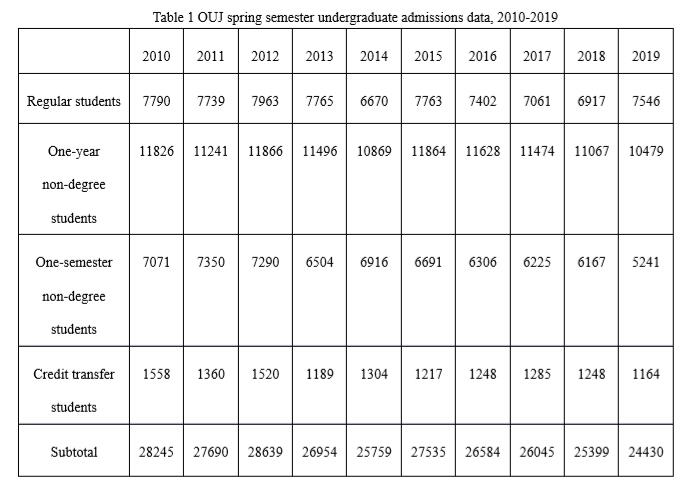 2. Active students
2. Active students
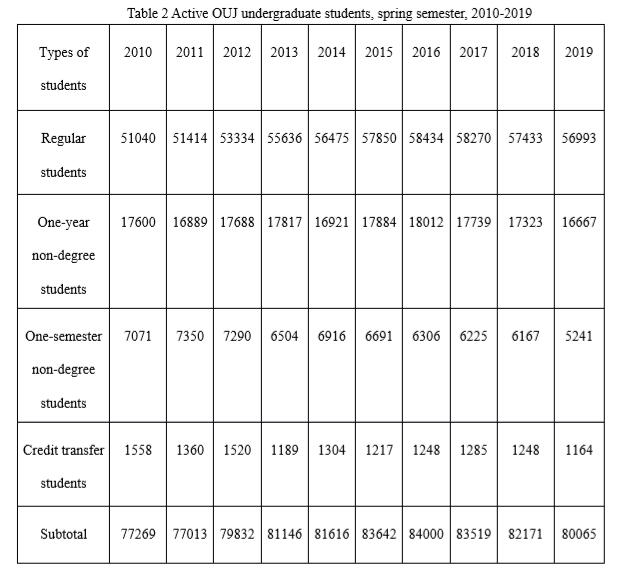
Table 2 shows the number of active students during the 10 years between 2010 and 2019. Initially, the total number of active students and the number of active regular students were gradually rising, reaching a peak in 2016. After 2016, the numbers gradually dropped. However, a comparison of the data from 2019 and 2010 reveals that the numerical value increased, while the conditions of one-year non-degree students, one-semester non-degree students, and credit transfer students all basically showed a downward trend. The number of credit transfer students saw the largest drop.
3. Active students by age
Table 3 shows the number of active OUJ undergraduate students by age. Figures 1 and 2 are sketch maps of the proportion of active students of different age groups from 2013 to 2019. Both the table and figures show a clear increase in the number of students aged 60 or above. Comparing 2019 and 2013 shows that the number of active students aged 60 or above increased by 5.21%, becoming the largest group.
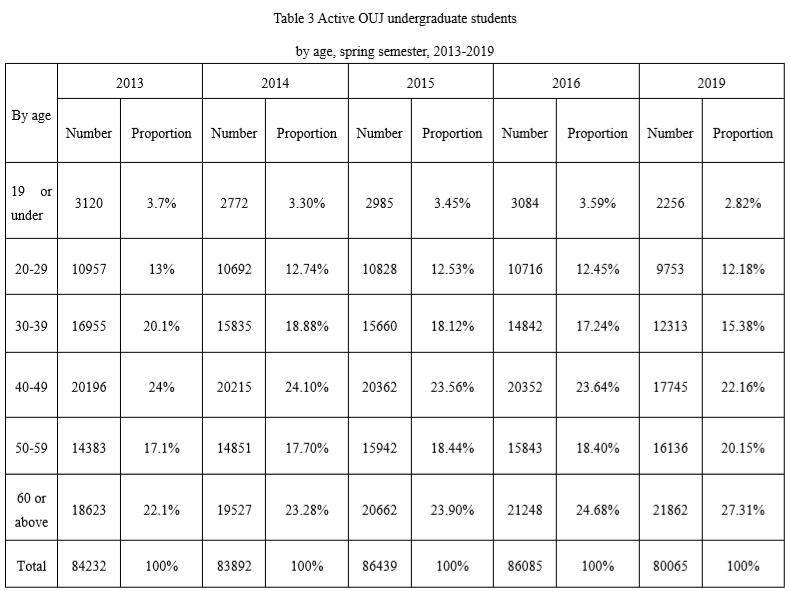
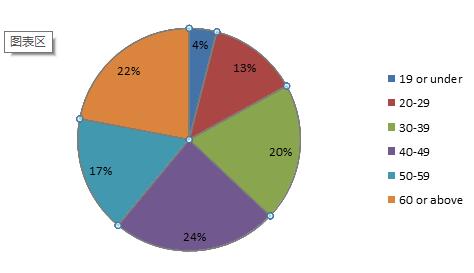
Figure 1 Sketch map of the proportion of active OUJ students by age group in 2013
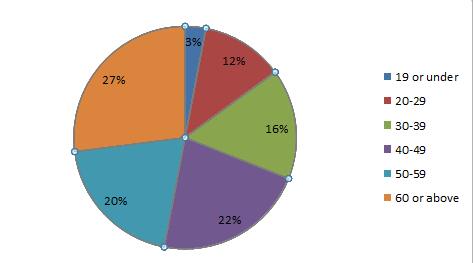
Figure 2 Sketch map of the proportion of active OUJ students by age group in 2019
4. Basic conclusions
The following basic conclusions can be drawn from an analysis of relevant OUJ student data over the past 10 years.
First, the overall number of undergraduate showed a declining trend.
Second, the year 2016 marked the peak of the total number of active undergraduate students, and that although there was an overall declining trend, the total number of 2019 students in 2019 was still higher than2010.
Third, there was an obvious rising trend in the number of undergraduate students aged 60 or above, and they became the largest active student group, accounting for 27.31% of the total.
5. On the enrolment of master’s and PhD students
Though this essay does not provide the data, it can report that the data show that the total number of active master’s students fluctuated over the course of the same 10 years, but showed a general downward trend with quite a steep drop; however, the number of older adults aged 60 or above showed an obvious rise, accounting for 31.66% in 2019.
The OUJ’s PhD programme was established in 2014. Approximately 12 students are accepted once a year. By 2019, 74 students had been admitted. As of the spring semester of 2019, there had been a total of 15 graduates.